Queue Systems in Retail: Enhancing Efficiency and Customer Satisfaction
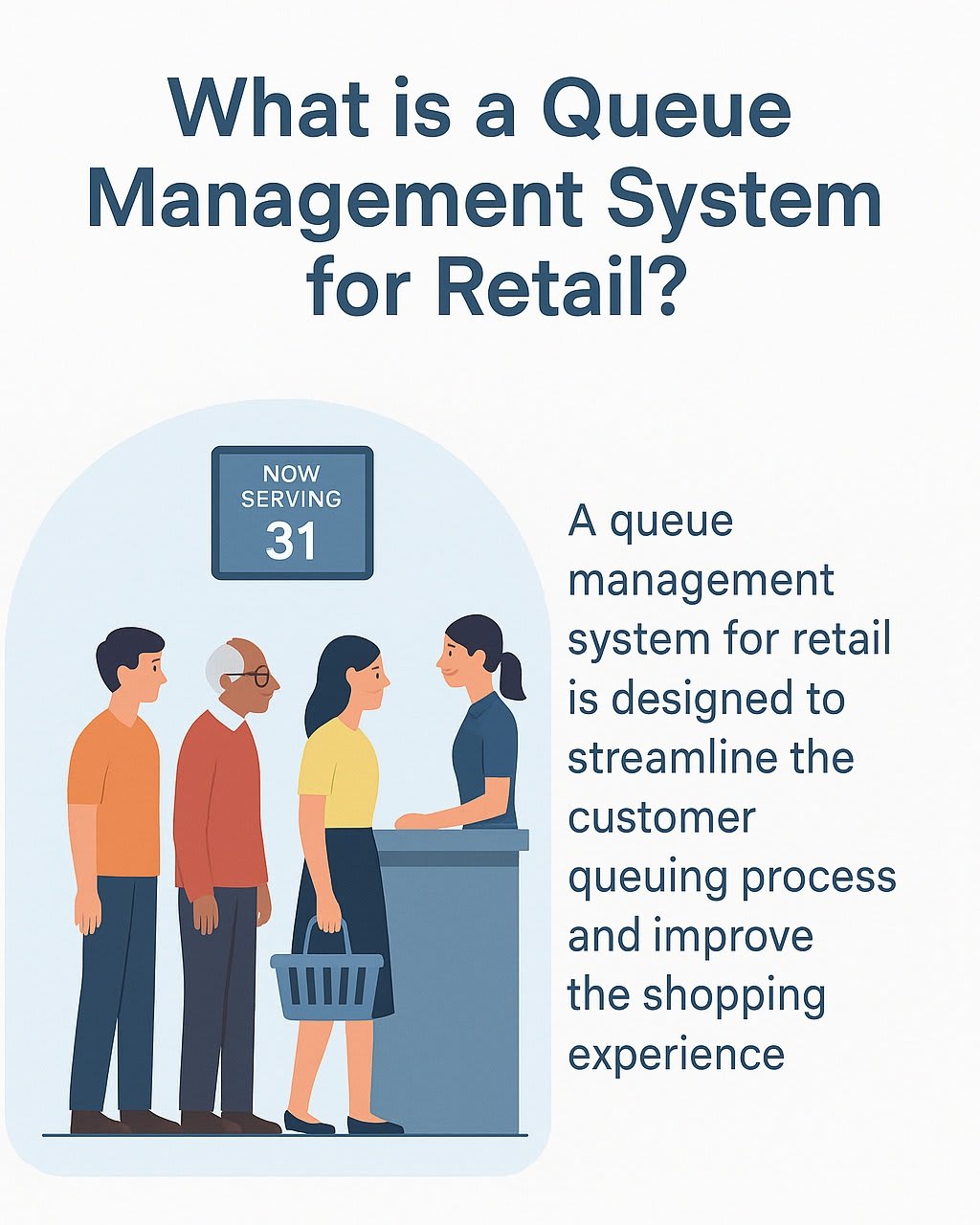
In the fast-paced world of retail, every second counts. Shoppers expect a smooth, quick, and efficient experience, and any friction in their journey can result in lost sales and diminished brand loyalty. One of the most critical — yet often overlooked — components of this experience is how retailers manage queues. A robust retail queue management system is not just about reducing wait times; it’s a strategic tool that can dramatically enhance customer satisfaction, drive sales, and streamline operations.
The Challenge: Queues in the Modern Retail Environment
The modern retail landscape is more competitive than ever. With the rise of e-commerce, brick-and-mortar stores must find innovative ways to provide value and retain customers. Long or mismanaged queues are a leading cause of customer dissatisfaction. According to a 2023 survey by Omnico Group, 75% of shoppers said they would abandon a purchase if they faced a long wait. Even more, over 50% said they are less likely to return to a store after a poor queuing experience.
Retailers are realizing that investing in a queue management system for retail is not optional—it’s essential.
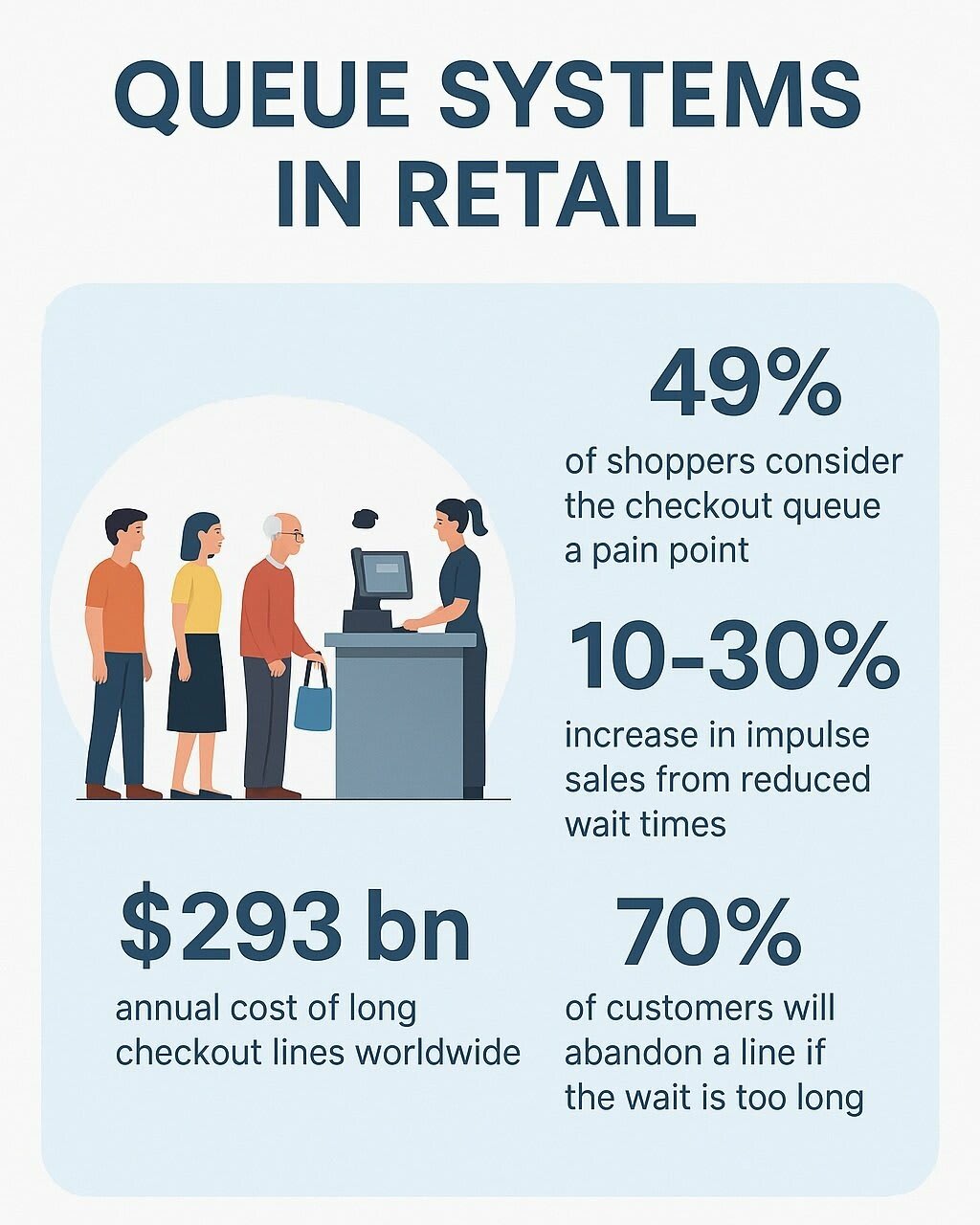
Queue Systems in Retail – Impact on Customer Behavior
How checkout wait times affect customer satisfaction, sales, and queue abandonment, with key global statistics.
Need a laugh (and a reality check)? Here's how boring queues drive customers away.
What Is a Retail Queue Management System?
A retail queue management system is a set of integrated technologies and processes that help manage customer flow within retail environments. This includes:
Digital ticketing systems
Virtual queue apps
Real-time analytics and dashboards
SMS or mobile notifications
Self-service kiosks
In-store traffic management solutions
AI-powered forecasting and queue prediction tools
Touchless entry and check-in systems
These tools work together to minimize perceived and actual wait times, enhance customer engagement, and provide valuable insights into shopper behavior.
Types of Queue Management Systems for Retail
Physical Queue Systems: Traditional line management with barriers and signage, commonly seen in grocery and high-traffic stores.
Virtual Queue Systems: Customers join a virtual digital queue via a mobile app or in-store kiosk and receive updates on their place in line.
Appointment-Based Systems: Customers schedule in-store visits ahead of time, especially common in electronics, healthcare retail, and luxury retail.
Hybrid Queue Systems: Combines physical and virtual elements to offer maximum flexibility.
Each type of queue management system retail businesses adopt depends on store size, customer base, and operational goals.
Why Retail Queue Management Is Crucial
1. Boosts Customer Satisfaction
Queue management directly impacts how customers perceive a brand. A queue management system for retail can reduce wait time anxiety by keeping customers informed through digital signage or app notifications. This transparency builds trust and loyalty.
2. Increases Sales and Conversion Rates
A well-managed queue keeps customers engaged and less likely to abandon their purchases. Studies show that retailers using queue management systems have seen sales increase by up to 20% due to reduced walkaways. A smooth experience keeps people in-store longer, increasing basket size and impulse purchases.
3. Improves Operational Efficiency
Real-time data from retail queue management systems allows managers to make informed decisions, such as opening more tills or reallocating staff. This responsiveness prevents bottlenecks and optimizes resources during peak hours.
4. Enhances Staff Productivity
With automated systems in place, staff can focus on assisting customers rather than crowd control. This improves service quality, increases upselling opportunities, and boosts team morale.
5. Provides Actionable Insights
Queue data reveals customer flow patterns, peak hours, and service bottlenecks. Retailers can use these insights to improve store layout, optimize staffing schedules, reduce labor costs, and even target promotions during high-traffic times.
According to McKinsey, businesses that use customer data effectively see 23% higher profits
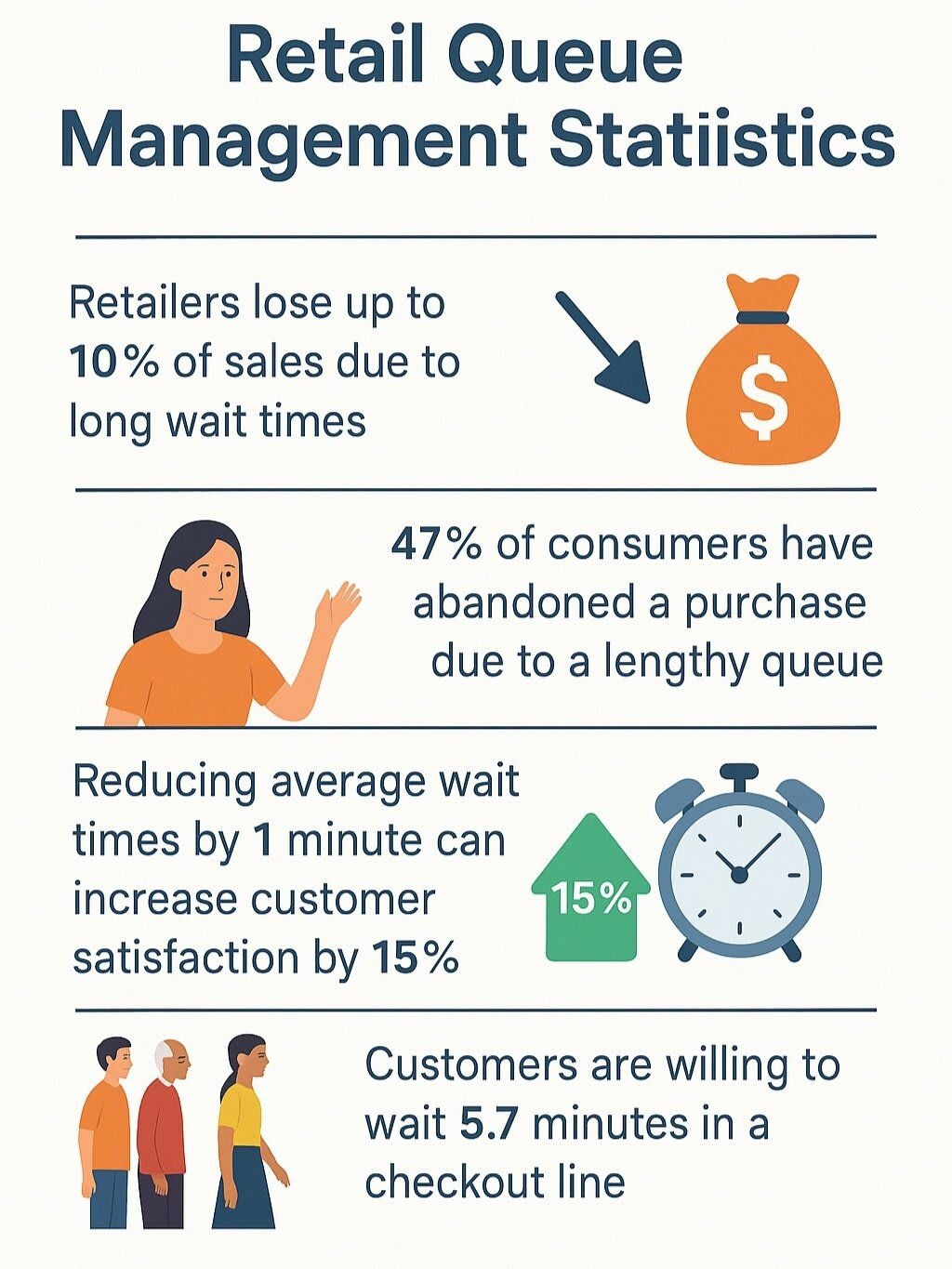
Retail Queue Management Statistics
Data-driven infographic presenting critical retail statistics about queue lengths, sales losses, and customer behavior.
Case Studies and Industry Statistics
Zara implemented a smart queue system across several flagship stores and saw a 30% reduction in checkout wait times, leading to improved customer retention.
Best Buy adopted an appointment-based system for high-value tech purchases, which led to a 15% increase in conversion rates and a better-managed sales process.
Decathlon integrated a hybrid queue management solution, resulting in 27% higher customer satisfaction scores.
If you’re ready to go beyond the humor and dive into the strategic why of queue management, explore our business-focused breakdown.
According to RetailWire, 62% of customers said that stores with shorter wait times were more likely to earn their loyalty.
QueueAway Case Studies can be examined here
Technologies Powering Modern Queue Systems
1. AI and Machine Learning
AI helps predict peak times, understand customer flow, and recommend staffing levels in real time. It enables smarter queue routing based on service demand.
2. IoT Sensors
Track real-time occupancy and queue length using ceiling-mounted sensors or floor-based pressure mats. Alerts are sent to management dashboards when thresholds are exceeded.
3. Mobile Integration
Allow customers to check in remotely, receive estimated wait times, and get notified when it’s their turn. This is crucial in providing a contactless experience.
4. Digital Signage
Display real-time queue updates and promotional content to keep waiting customers engaged and informed.
5. Cloud-Based Dashboards
Centralize data from multiple store locations to enable performance tracking, benchmarking, and real-time adjustments.
6. Biometric Check-ins
Fingerprint and facial recognition are being tested in some retail environments for loyalty members to skip the line securely.
The ROI of Retail Queue Management Systems
Investing in a queue management system retail environment doesn’t just improve CX—it delivers measurable returns:
Reduced abandoned purchases due to lower perceived wait times
Higher average transaction values by maintaining engagement
Lower staff turnover due to streamlined workflows and reduced stress
Improved Net Promoter Scores (NPS) and customer retention rates
A UK-based department store reported a return on investment of 7:1 within the first year of implementing a digital queue system. Another midsize retail chain saw a 12% increase in repeat visits after deploying queue analytics.
How Queue Management Influences Brand Perception
Today’s customer experience begins long before checkout. When customers feel their time is respected, they associate that efficiency with the brand. According to a 2022 Salesforce study, 84% of customers say the experience a company provides is as important as its products or services.
Providing a seamless retail queue management system not only creates a frictionless experience but also strengthens brand identity.
86% of customers would pay more for a better experience - Forbes
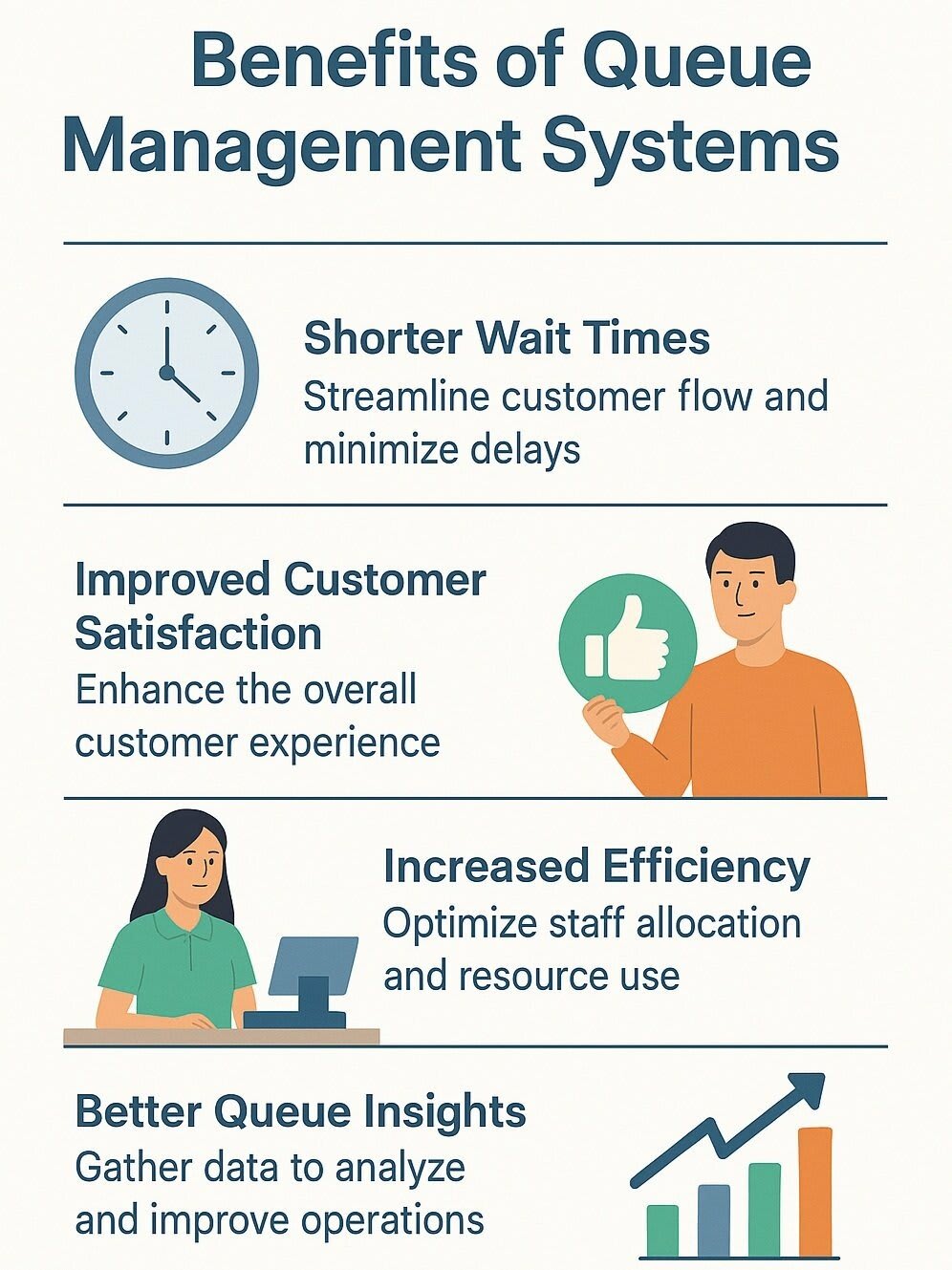
Benefits of Queue Management Systems
Four key advantages of queue management systems: wait time reduction, customer satisfaction, efficiency, and data insights.
Future Trends in Retail Queue Management
1. Touchless Solutions
Post-COVID, the demand for contactless tech remains high. Virtual queues, QR codes, and voice-activated kiosks are fast becoming the new standard.
2. Personalized Experiences
AI-driven systems tailor queue notifications and in-queue promotions based on customer profiles, shopping history, and loyalty status.
3. Integration with Loyalty Programs
Customers with higher loyalty tiers can benefit from priority queuing, skip-the-line privileges, or earn rewards for check-in behavior.
4. Omnichannel Queue Management
Future systems will manage queues across physical stores, curbside pickup, customer service desks, and online service channels, creating a fully unified experience.
5. Augmented Reality (AR) Guidance
Some retailers are experimenting with AR wayfinding to guide customers to check-in points or available service counters.
How to Choose the Right Queue Management System for Retail
Key Considerations:
Scalability: Ensure the system can grow with your business and handle peak traffic.
Customizability: Must align with your brand voice and CX strategy.
User Experience: Simple interfaces for staff and customers alike.
Integration: Should work with POS systems, CRM, and loyalty programs.
Data & Analytics: Powerful dashboards and reporting features are non-negotiable.
Retailers looking to leverage customer data and analytics should check out our guide to queue management system software.
Vendor Support: Look for vendors with strong SLAs and responsive customer support.
A strong retail queue management system should adapt to your unique needs while staying ahead of technological trends and customer expectations.
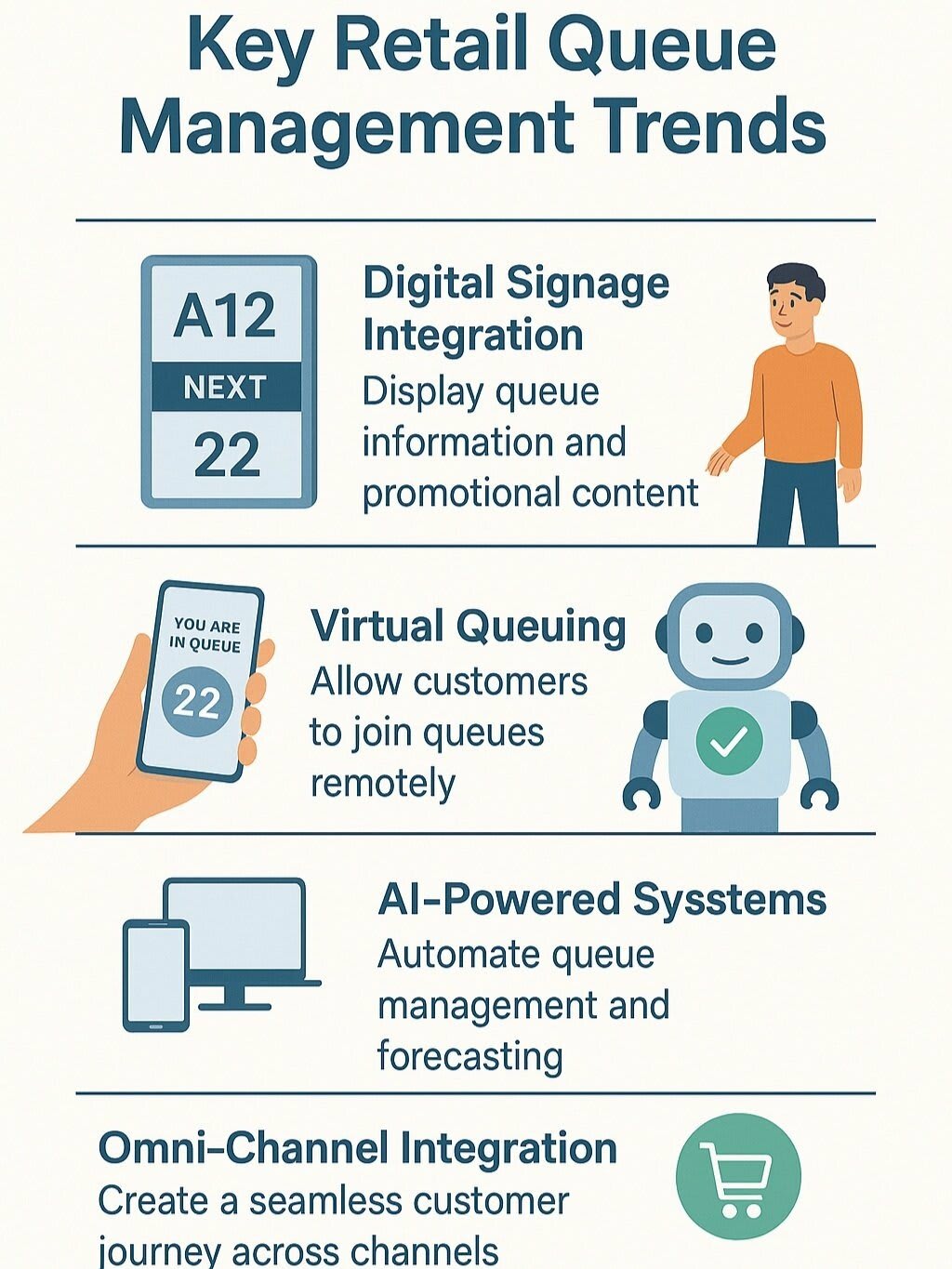
Key Retail Queue Management Trends
Forward-looking highlighting emerging trends in retail queue management, including AI, digital signage, and omnichannel integration.
Retail is just one of many sectors benefitting — explore the full impact in our ultimate queue management guide.
QueueAway: Your Partner in Retail Queue Optimization
QueueAway offers state-of-the-art queue management system for retail solutions that combine all the above technologies in a seamless package. Whether you're a single boutique or a national retail chain, our tools help you:
Reduce queues and improve walk-in flow
Offer appointment bookings and virtual waiting rooms
Engage customers with real-time updates
Optimize staffing and resource planning with predictive analytics
Drive ROI through customer loyalty and improved operational efficiency
If you're exploring broader queue management strategy, don’t miss our ultimate overview guide.
Frequently Asked Questions (FAQs)
What is a retail queue management system?
A retail queue management system is a combination of technologies and processes designed to manage customer flow within retail environments. This includes tools like digital ticketing systems, virtual queue apps, real-time analytics dashboards, SMS or mobile notifications, self-service kiosks, and AI-powered forecasting tools. These systems aim to minimize wait times, enhance customer engagement, and provide valuable insights into shopper behavior.
Why is queue management important in retail?
Effective queue management is crucial in retail because long or mismanaged queues can lead to customer dissatisfaction, abandoned purchases, and reduced brand loyalty. According to a 2023 survey by Omnico Group, 75% of shoppers said they would abandon a purchase if they faced a long wait, and over 50% are less likely to return to a store after a poor queuing experience. Implementing a queue management system helps streamline operations, improve customer satisfaction, and drive sales.
What types of queue management systems are used in retail?
Retailers utilize various types of queue management systems, including:
Physical Queue Systems: Traditional line management with barriers and signage.
Virtual Queue Systems: Customers join a digital queue via a mobile app or in-store kiosk and receive updates on their place in line.
Appointment-Based Systems: Customers schedule in-store visits ahead of time, common in electronics, healthcare retail, and luxury retail.
Hybrid Queue Systems: Combines physical and virtual elements to offer maximum flexibility.
How does a virtual queue system enhance the retail experience?
A virtual queue system allows customers to join a queue remotely using their smartphones or in-store kiosks. They receive real-time updates on their position in line, estimated wait times, and notifications when it's their turn. This reduces the need for physical waiting, enhances customer satisfaction, and allows retailers to manage customer flow more efficiently.
What are the benefits of implementing a queue management system in retail?
Implementing a queue management system in retail offers several benefits:
Reduced Wait Times: Streamlines the checkout process and minimizes customer wait times.
Improved Customer Satisfaction: Enhances the shopping experience, leading to increased customer loyalty.
Operational Efficiency: Provides real-time data and analytics to optimize staff allocation and store operations.
Increased Sales: Reduces cart abandonment and encourages repeat business.
Competitive Advantage: Differentiates the store by offering a seamless and efficient shopping experience.
Final Thoughts
Retailers who overlook the importance of effective queue management risk not just dissatisfied customers but also lost revenue and competitive disadvantage. The data is clear: consumers value their time, and how that time is respected significantly shapes their buying decisions.
Implementing a powerful queue management system for retail is one of the smartest investments a business can make today. It enhances every aspect of the customer journey while providing retailers with actionable data to fine-tune operations.
For modern retail success, efficient retail queue management is no longer a luxury—it’s a necessity. Don't let your queues hold your business back—let QueueAway streamline your operations and elevate your customer experience today.
Book a Demo today


